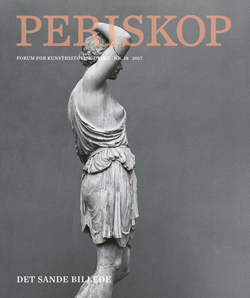Billedrummet som et levende atlas i verden En introduktion til Georges Didi-Hubermans billedpolitiske projekt og kuratoriske praksis
DOI:
https://doi.org/10.7146/periskop.v15i18.105146Resumé
The Image as a Living Atlas in the World. An Introduction to
George Didi-Huberman’s Image Theory Project and Curatorial Practice
This article delivers both an overview of the ongoing work of art historian Georges Didi-Huberman (b. 1953) and an attempt at analyzing the incarnational conception of images that runs through Didi-Huberman’s image theory. In the Christian tradition, images are the result of an incarnational double-economy. Didi-Huberman’s early interpretations in Fra Angelico, dissemblance et figuration are central to our understanding of this incarnational economy. The visible is capable of entering our flesh; to control this incarnational invasion, Christian tradition has developed a reflexive capacity to read these invasions as images in acts of exegesis. This reflexive exegetical economy is pivotal for Didi-Huberman’s political position regarding our modern use and abuse of images. Confronted with Pier Paolo Pasolini’s conviction that we live in a fascistic state of emergency that blinds our senses with total illumination, Didi-Huberman insists in believing that the described reflexive double-economy is still enabling us to let the visible enter our bodies and light up the darkness of our flesh from within as images – thereby developing our imagination and freeing us from the deadening total image that is fascism.
Downloads
Publiceret
Citation/Eksport
Nummer
Sektion
Licens
Copyright (c) 2018 Forfatteren og Periskop

Dette værk er under følgende licens Creative Commons Navngivelse (by).
Forfattere, der publicerer deres værker via dette tidsskrift, accepterer følgende vilkår:
- Forfattere bevarer deres ophavsret og giver tidsskriftet ret til første publicering, samtidigt med at værket 12 måneder efter publiceringen er omfattet af en Creative Commons Attribution-licens, der giver andre ret til at dele værket med en anerkendelse af værkets forfatter og første publicering i nærværende tidsskrift.
- Forfattere kan indgå flere separate kontraktlige aftaler om ikke-eksklusiv distribution af tidsskriftets publicerede version af værket (f.eks. sende det til et institutionslager eller udgive det i en bog), med en anerkendelse af værkets første publicering i nærværende tidsskrift.
- Forfattere har ret til og opfordres til at publicere deres værker online (f.eks. i institutionslagre eller på deres websted) forud for og under manuskriptprocessen, da dette kan føre til produktive udvekslinger, samt tidligere og større citater fra publicerede værker (se The Effect of Open Access).


